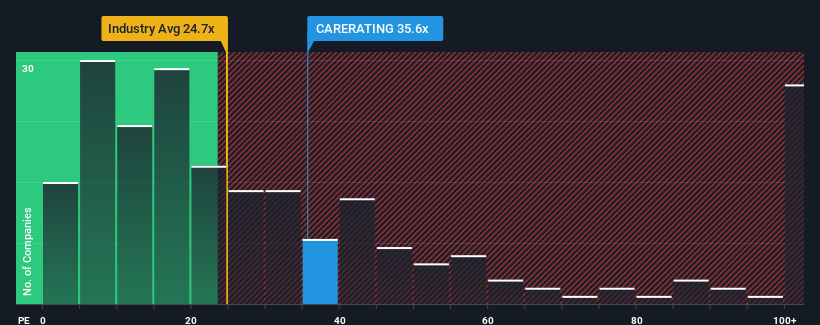- India
- /
- Capital Markets
- /
- NSEI:CARERATING
CARE Ratings Limited's (NSE:CARERATING) Business Is Yet to Catch Up With Its Share Price

CARE Ratings Limited's (NSE:CARERATING) price-to-earnings (or "P/E") ratio of 35.6x might make it look like a sell right now compared to the market in India, where around half of the companies have P/E ratios below 31x and even P/E's below 17x are quite common. Although, it's not wise to just take the P/E at face value as there may be an explanation why it's as high as it is.
With earnings growth that's inferior to most other companies of late, CARE Ratings has been relatively sluggish. One possibility is that the P/E is high because investors think this lacklustre earnings performance will improve markedly. If not, then existing shareholders may be very nervous about the viability of the share price.
See our latest analysis for CARE Ratings

How Is CARE Ratings' Growth Trending?
The only time you'd be truly comfortable seeing a P/E as high as CARE Ratings' is when the company's growth is on track to outshine the market.
Retrospectively, the last year delivered a decent 10% gain to the company's bottom line. EPS has also lifted 20% in aggregate from three years ago, partly thanks to the last 12 months of growth. Accordingly, shareholders would have probably been satisfied with the medium-term rates of earnings growth.
Shifting to the future, estimates from the only analyst covering the company suggest earnings should grow by 25% over the next year. That's shaping up to be similar to the 25% growth forecast for the broader market.
With this information, we find it interesting that CARE Ratings is trading at a high P/E compared to the market. It seems most investors are ignoring the fairly average growth expectations and are willing to pay up for exposure to the stock. Although, additional gains will be difficult to achieve as this level of earnings growth is likely to weigh down the share price eventually.
The Key Takeaway
We'd say the price-to-earnings ratio's power isn't primarily as a valuation instrument but rather to gauge current investor sentiment and future expectations.
We've established that CARE Ratings currently trades on a higher than expected P/E since its forecast growth is only in line with the wider market. Right now we are uncomfortable with the relatively high share price as the predicted future earnings aren't likely to support such positive sentiment for long. Unless these conditions improve, it's challenging to accept these prices as being reasonable.
Don't forget that there may be other risks. For instance, we've identified 1 warning sign for CARE Ratings that you should be aware of.
Of course, you might also be able to find a better stock than CARE Ratings. So you may wish to see this free collection of other companies that have reasonable P/E ratios and have grown earnings strongly.
New: AI Stock Screener & Alerts
Our new AI Stock Screener scans the market every day to uncover opportunities.
• Dividend Powerhouses (3%+ Yield)
• Undervalued Small Caps with Insider Buying
• High growth Tech and AI Companies
Or build your own from over 50 metrics.
Have feedback on this article? Concerned about the content? Get in touch with us directly. Alternatively, email editorial-team (at) simplywallst.com.
This article by Simply Wall St is general in nature. We provide commentary based on historical data and analyst forecasts only using an unbiased methodology and our articles are not intended to be financial advice. It does not constitute a recommendation to buy or sell any stock, and does not take account of your objectives, or your financial situation. We aim to bring you long-term focused analysis driven by fundamental data. Note that our analysis may not factor in the latest price-sensitive company announcements or qualitative material. Simply Wall St has no position in any stocks mentioned.
About NSEI:CARERATING
CARE Ratings
A credit rating agency, provides various rating and related services in India and internationally.
Flawless balance sheet with reasonable growth potential and pays a dividend.
Market Insights
Community Narratives



